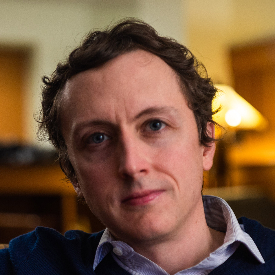Walter J. Scheirer is an Assistant Professor in the Department of Computer Science and Engineering at the University of Notre Dame. Previously, he was a postdoctoral fellow at Harvard University, with affiliations in the School of Engineering and Applied Sciences, Department of Molecular and Cellular Biology, and Center for Brain Science, and the director of research & development at Securics, Inc., an early-stage company producing innovative computer vision-based solutions. He received his Ph.D. from the University of Colorado and his M.S. and B.A. degrees from Lehigh University.
Below, Walter shares five key insights from his new book, A History of Fake Things on the Internet. Listen to the audio version—read by Walter himself—in the Next Big Idea App.

Why is there so much fake stuff on the Internet? It may have something to do with a rare civilizational transformation that is taking place right now. A transformation that is changing the way we share information, discuss ideas, and perceive our environment.
No longer content to live within the confines of the physical world, the global population has moved into alternate realities made possible by radical innovations in social technology. What began with the campaign to relocate as many aspects of our lives as possible into the smartphone has accelerated during the COVID-19 pandemic, with both work and play for many becoming virtualized.
The Internet presently exists as an extension of the world’s imagination, an unbounded fantasyland filled with various competing fictions. This has been a boon to creativity and may be jumpstarting a cultural renaissance like none other. But myriad dangers lurk there as well.
What exactly is going on out there in the digital terra incognita? This is a complex question. But if we could answer it, even partially, we would better understand the economic, political, and social landscape of contemporary life. Commentators on this matter tend to have a strong penchant for decrying anything and everything that appears to be fake. This is because it lures the mind away from an objective reality. For instance, if we are drawn to a piece of fake news, bad things will follow, right? Maybe. Or maybe not.
1. There is a long history of photographic manipulation.
Today’s most popular content on the Internet consists of images and videos posted to social media services like Instagram and TikTok. The possibility of an altered photo revising history in a convincing way highlights a salient threat of imaging technology. After all, seeing is believing. Or is it?
While we tend to think of Adobe’s Photoshop software as a novel innovation, the objectives of photographic manipulation have remained largely the same since the camera first appeared in the 19th century. For instance, the first fake photograph was staged in dramatic fashion by the inventor of one of the first film cameras in the 1840s, and darkroom technicians had numerous special effects at their disposal for editing photos in the decades that followed. This included everything from facial retouching for portraits to the creation of whimsical photomontages. When one sat for a professional photo in this era, any number of effects could be ordered from a catalog made available to customers. When we think about digital technology today, the old battle-worn techniques from the era of film photography have simply evolved to keep pace with technological developments.
“Photographs are social objects that can be interrogated in different ways by different observers.”
The reception of photo editing and its relationship to the notion of reality is more significant than the technologies themselves. The documentary filmmaker Errol Morris explored this idea in a series of essays he published over a decade ago. To quote Morris, “The idea that photographs hand us an objective piece of reality, that they by themselves provide us with the truth, is an idea that has been with us since the beginnings of photography. But photographs are neither true nor false in and of themselves. They are only true or false with respect to statements that we make about them or the questions that we might ask of them.” In other words, Morris is telling us that photographs are social objects that can be interrogated in different ways by different observers. That has always made them an interesting tool for storytelling.
2. The examples of photographic manipulation that history has preserved make it clear that the observer is more often than not meant to understand that something has changed.
Looking back in time, one routinely finds examples of photographic propaganda where a scene has been altered in an obvious way. For instance, the presence of large gaps in group photographs of Soviet leaders signaled that political adversaries had been purged. Thus, a particular political narrative such as “don’t run afoul of the ruling party” could be conveyed through a visual medium. The fact that the observer is meant to understand that such a photo has been changed in an intentional way is surprising at first glance. But in context, it makes sense, given how people understand the very notion of truth.
Writing on totalitarian governments in the 20th century, the philosopher Hannah Arendt dismissed the possibility that history could be revised in a plausible manner because the truth of a matter is unmovable. In her words: “Conceptually, we may call the truth what we cannot change; metaphorically, it is the ground on which we stand and the sky that stretches above us.”
Arendt’s use of the word “we” is important here, as it emphasizes the social context of the truth. If many people observed an event unfolding one way, produced records of it, and related their experience to others, it becomes an insurmountable task to convince them otherwise later. We see this effect clearly in the failure of realistic Deepfake videos of public figures to influence viewer behavior.
“Some memes are innocent jokes, while others are deceitful and laced with violent rhetoric.”
A Deepfake is a video of a person that has been edited by AI to change what they are saying in a naturalistic way. After the first Deepfake algorithm appeared on the Internet in 2017, many assumed it would have an enormous impact on politics. But this hasn’t happened. For instance, the Deepfake of Ukrainian president Volodymyr Zelensky asking his armed forces to stand down shortly after the Russian invasion of his country in 2022 did nothing to change the course of the war. Far too many people involved in the conflict were connected to Zelensky’s government and knew he had made no such statement. The armed forces of Ukraine did not leave their trenches and continued to fight without paying any attention to the video.
Yet, one can always make obvious changes to a photo that will avoid this dilemma entirely. And obvious changes tend to resonate better with an audience that is sympathetic to the message being conveyed. We can see this effect clearly by considering an example from the present day: the popularity of image-based memes. On the Internet, memes are most commonly found in the form of images meant to be remixed and shared by the receiving audience. This type of content is also used to tell stories, often making social or political commentary. Some memes are innocent jokes, while others are deceitful and laced with violent rhetoric. Successful memes, in this latter vein, amplify bad information as they traverse social media. Ordinary people on the Internet can work on political storylines through memes, meaning major media outlets are no longer needed to shape the broader conversation around contemporary events. When it comes to disinformation, the perfect fake is neither prevalent nor effective. Thus, on the Internet, it is memes all the way down.
3. While there is a lot of violent rhetoric and imagery in today’s memes, much of it is tongue-in-cheek, more satirical than diabolical.
This material has been routinely misunderstood and decried by social critics, who habitually stop at the surface-level message of content that can be understood at multiple levels. Accordingly, there has been a rapid decline in real-life forums where social concerns can be aired in an exaggerated form to which people are highly receptive.
For instance, consider the recent backlash against stand-up comedy. Contemporary social norms have now made discussing certain things in the open completely unacceptable, especially if ideas that push back against dominant media narratives are raised. Yet, there is still a strong sentiment to do so. Forbidden ideas of this sort are now channeled into disquieting social media posts that are released under the veil of anonymity to jolt the masses into thinking critically about things. The question is whether this activity will heighten human awareness of responsibility or drag us all to hell.
4. Computer hackers played a significant role in pioneering the strategies of fakery that are so popular today.
Back in the 1990s, hacking was a vibrant underground subculture whose activities were not limited to just breaking into computers. Hackers were generally interested in using technology in unanticipated ways, including as a conduit to change the world around them as they saw fit. In this regard, producing fake digital material delivered via the Internet was a surefire strategy for success.
“While many hackers enjoyed the challenges of the technical aspects of computer hacking, these operations with a strong social element were often far more effective.”
The manipulation of the news media by hackers was routine. And plenty of targeted disinformation campaigns against major corporations and world governments existed. Amateurs on the Internet could force the world’s power centers to react to their antics with relatively little effort. While many hackers enjoyed the challenges of the technical aspects of computer hacking, these operations with a strong social element were often far more effective. Early cases of digital disinformation are legendary to hackers but largely unknown to the public. Is there some connection to the participatory fakery of today? The answer is yes, and it centers around the culture of the Internet itself.
5. There are two competing visions for the Internet: The Information Superhighway of the 1990s and the creative space described by the media theorist Marshall McLuhan in the 1960s.
At the dawn of the dot-com boom of the 90s, large corporations pushed a bland vision of the Internet as a database of facts that would be used for commerce and other serious matters. This was the vaunted Information Superhighway, and it was a vision that was never really achieved, nor particularly popular with the public.
This is because computer hackers built the infrastructure for the Internet based on McLuhan’s more radical thinking that the Internet would be an extension of the central nervous system, relaying information directly from the mind to the virtual world in real-time. That meant that not everything found on the Internet would be “real” in a physical sense, but if one were trying to escape the confines of the physical world, this wouldn’t be a problem.
In fact, quite the opposite. Consider the human capacity for imagination and how it has directed culture over the centuries. Reality has always been shaped by ideas that are projections of the imagination. This is an essential aspect of our humanity. The imagination’s move into information networks like the Internet reflects a natural progression of technological development that mirrors this phenomenon. And the entire globe has embraced this evolution with zeal.
To listen to the audio version read by author Walter Scheirer, download the Next Big Idea App today:






























